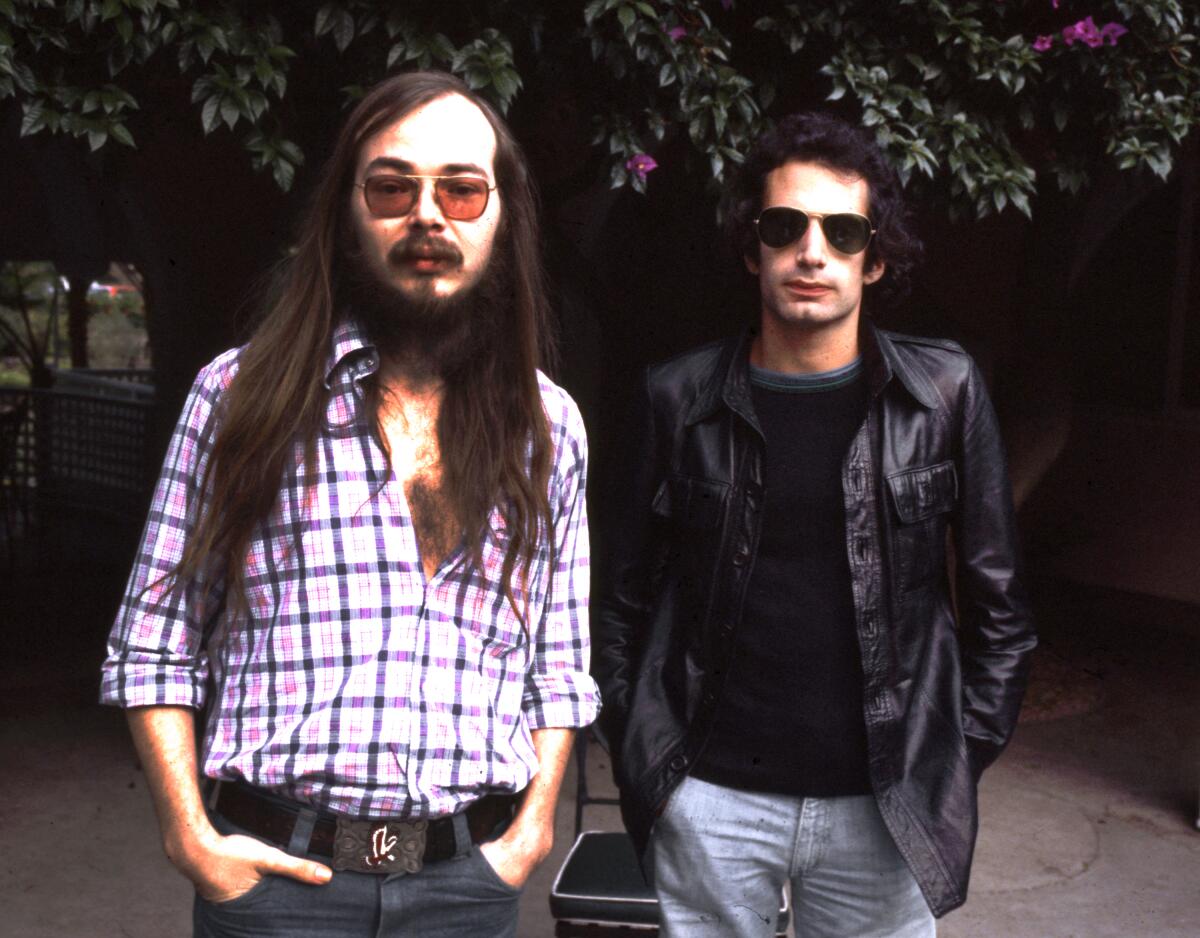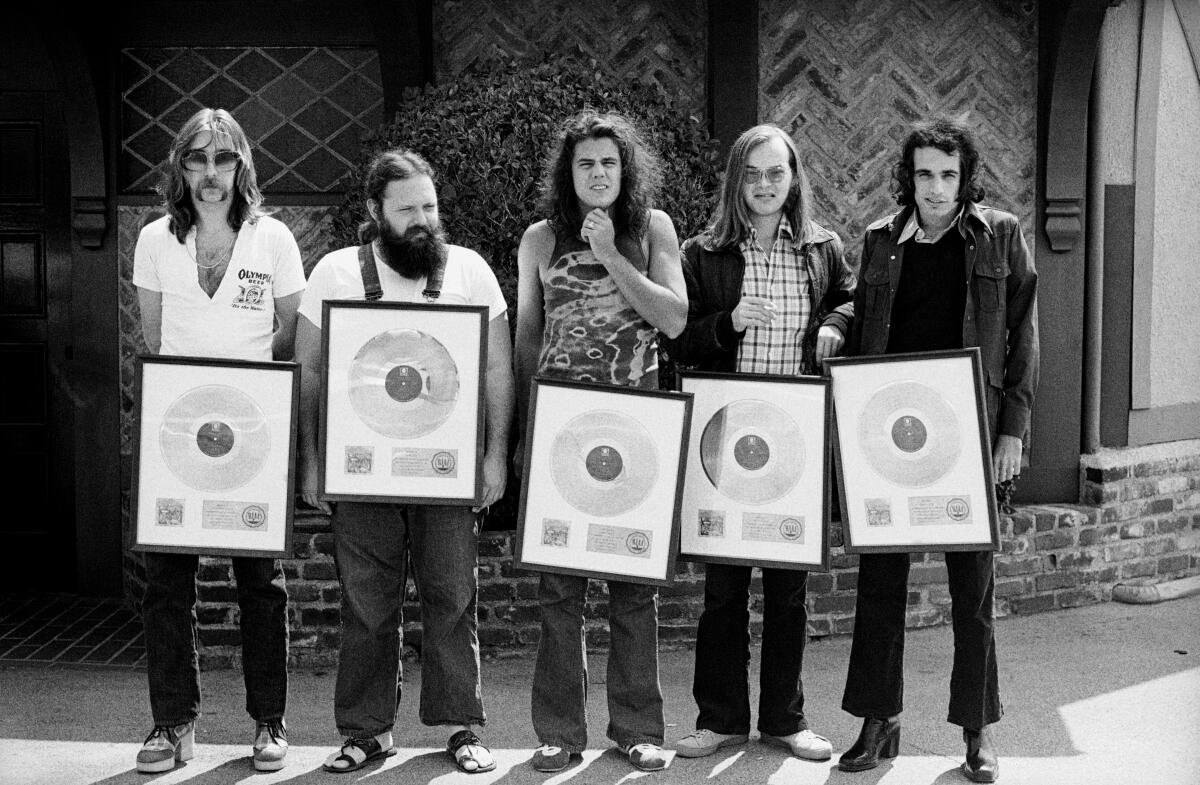How millennials came to unironically love yacht-rock kings Steely Dan

- Share via
This essay is adapted from Alex Pappademas and Joan LeMay’s “Quantum Criminals: Ramblers, Wild Gamblers, and Other Sole Survivors from the Songs of Steely Dan.
*****
A few months after Steely Dan co-founder Walter Becker died — in 2017, at 67, of esophageal cancer — his widow Delia Becker wrote in a statement that he’d been cremated, per his wishes, “without ceremony or memorial.”
This doesn’t mean he wasn’t publicly mourned. On the day Becker died, Donald Fagen — the other half of Steely Dan’s creative core — issued a statement recalling his longtime writing partner as “cynical about human nature, including his own, and hysterically funny.” Becker’s passing was marked on social media by his generational and actuarial peers — Kiss’ Paul Stanley, the Heartbreakers’ Benmont Tench, Chic’s Nile Rodgers and P-Funk’s Bootsy Collins — but also by Roots bandleader Ahmir “Questlove” Thompson, who called Walter an “artist’s artist,” and producer Mark Ronson, who called Becker “one-half of the team I aspire to every time I sit down at a piano.” Opening for U2 in Detroit that weekend, Beck paid tribute to “a rock ‘n’ roll hero” by slipping a few bars of “Josie” into “Where It’s At.” Fans both likely and unlikely came out of the woodwork: Best Coast’s Bethany Cosentino and Bryan Adams, Mac DeMarco and Slash, Julian Lennon and Thundercat, John Mulaney and Just Blaze, not to mention countless regular people testifying that they too had been shaped — or warped — by Becker and Fagen’s work.

Steely Dan had been a popular 1970s rock band for a while, with a bunch of songs that made the charts, and rock ’n’ roll never forgets. But then they stopped being a band for a while, and in the ensuing years, their work — lyrically abstruse jazz-inflected rock songs about sad-sack characters spiraling toward chemical or existential doom, with musical accompaniment by ad-hoc bands of sidemen, recruited for their technical hyperproficiency — had earned a reputation as an acquired taste, like a savory fruit or a funky soft cheese. If you were a fan, the outpouring of sadness and gratitude that followed Becker’s death felt validating, but also discombobulatingly unanimous. Our little cult no longer seemed quite so cult-y.
In 2019, two years after Becker died, the online music magazine Pitchfork ran a week of newly commissioned retrospective reviews of classic Steely Dan albums like “Katy Lied” (rated 9.1 out of 10), “Gaucho” (9.4) and “Aja” (a perfect 10). In the 22 years between its inception in 1996 and the day the first of these reviews went live, Pitchfork had published exactly one other piece of critical writing about Steely Dan: writer Brent DiCrescenzo’s vitriolic review of Steely Dan’s 2000 reunion album “Two Against Nature” (1.6). The piece is a snapshot of how negatively Steely Dan were viewed at the turn of this century, particularly by people whose tastes and values were shaped by late-’80s/early-’90s indie rock. There are two separate ponytail jokes in the first paragraph alone; DiCrescenzo goes on to compare “Two Against Nature” to late-period Rush, “a Daniel Lanois–produced collaboration between the Dave Matthews Band and Kenny G,” and the evil robot spider Will Smith blows up at the end of “Wild Wild West.” “Remember,” DiCrescenzo writes, “this glossy bop-pop was the indifferent aristocracy to punk rock’s stone-throwing in the late ’70s. People fought and died so our generation could listen to something better. ... Put down this sports-utility vehicle of a record.”
Walter Becker, co-founder with Donald Fagen of Steely Dan, died Sunday at age 67.
Prior to a few years ago, this was how anyone opposed to the received wisdom of the boomer classic-rock canon was almost obligated to feel about Steely Dan — which is ironic, since more than a few influential boomer critics hated the group too. In the 1979 edition of the “Rolling Stone Record Guide,” writer Dave Marsh — keeper of the flame for a strain of rock and soul that took pride in simplicity and visceral directness — rates no Steely Dan album lower than 3 stars out of 5, but scorns the “unparalleled pretentiousness” of everything they did after 1974’s “Pretzel Logic.” In 1979, Steely Dan’s perceived artiness constituted a betrayal of rock music’s core values — what Marsh, assessing Bruce Springsteen much more favorably in the same Rolling Stone book, calls “the hopes and dreams of the rock tradition as handed down from Presley.” And by the turn of the millennium, the band had come to represent an affront to the values that indie rock had inherited from punk — a genre often romanticized as having emerged as a necessary corrective to slick mainstream 1970s and ’80s music made in expensive studios by self-regarding cocaine addicts.
In the 2000s, reflexive anti-Dan sentiment even found its way into the work of actual Steely Dan fans. On the day Becker died, writer-director Judd Apatow tweeted, “I have played no band more often or enjoyed any music more than Steely Dan.” But in Apatow’s 2007 film “Knocked Up,” Seth Rogen’s character Ben argues about Steely Dan’s virtues with Pete, played by Paul Rudd. Pete insists they’re incredible; Ben doesn’t buy it. “If I ever listen to Steely Dan,” he says, “I want you to slice my head off with an Al Jarreau LP.” Apatow later wrote on Twitter that Ben’s disdain for Steely Dan “was a way to show how immature and not ready for a baby [Rogen’s character] was. Who could trust him?” But the moment can be read both ways. If you think Steely Dan are geniuses, Ben’s inability to appreciate them underlines how little he knows about the world. But if you’re not a fan, there’s nothing in the scene to suggest you’re wrong. Even a Dan fan like Apatow knew that in 2007 a joke at their expense would land, just like the running gag about Michael McDonald’s “Yah Mo B There” in Apatow’s “The 40-Year-Old Virgin.”
Sixteen years after “Knocked Up” came out, though, Michael McDonald is arguably hipper than he’s ever been. And while old-school indie stalwarts like producer Steve Albini have continued to hold the line — “I will always be the kind of punk who s— on Steely Dan,” he tweeted earlier this year” — the world seems increasingly full of Petes, not Bens.

Around 2020 an ongoing groundswell of semi-ironic Dan appreciation became a full-fledged revival — at least online, which in 2020 was technically where most things took place. On social media, Steely Dan memes have become a vibrant comedic subgenre unto themselves, thanks to Dan meme accounts with inside-baseball handles like Lester the Nightfly, I.G.Y. Azalea and Bodacious Callboys. A now-dormant Instagram account called People Dancing to Steely Dan celebrated just how well all forms of human movement seem to sync with the Dan’s smooth sounds. And the most striking thing about the Good Steely Dan Takes account on Twitter — which retweets pro-Dan sentiments alongside other Dan-related esoterica — is how many of those good Dan takes are written by or about people currently getting into Steely Dan (“seeing somebody discover Steely Dan is like seeing a kid that fell into some toxic goo realize they can fly. wholly joyful”). The account’s handle is @baddantakes because it was once an index of derogatory or ill-informed Dan tweets; as Steely Dan’s stock rose, the business model shifted.
The Steely Dan resurgence happened in part because revivalism is now a thermodynamic law of pop culture, and by the second decade of the 21st century, we’d strip-mined the past so thoroughly that there was nothing left to revive but the previously verboten. It’s partly because Becker and Fagen never really broke through as solo artists after Steely Dan went on hiatus at the turn of the ’80s, which means ’80s and ’90s kids didn’t grow up resenting them as classic-rock leftovers hogging MTV and VH1 airtime the way Don Henley or Lindsey Buckingham did. (The high-gloss alienation of late-’70s Steely Dan records like “Gaucho” is a prescient preview of the ’80s both sonically and spiritually, but it’s impossible to imagine Steely Dan as an active ’80s band. Go ahead and try to picture Walter and Donald sharing a mic with Cyndi Lauper on “We Are the World,” or giving earnest interviews to Mark Goodman on MTV — although they probably would have gotten along with the preternaturally jaded Kurt Loder.)
As with the recent resurgence of hipster interest in the Grateful Dead, some of this appreciation is ironic. Anyone who tweets something like “listening to ‘do it again’ by steely dan and daydreaming that I’m a quaaludes dealer in 1979 facing a crisis of faith after my houseboat sinks off the docks of Sausalito” is riffing on Steely Dan’s lyrical content but also on the band’s reputation as a CD-changer staple for divorced ’80s dads. Steely Dan are an endlessly meme-able band because they’re a hilarious concept on paper — two grumpy-looking guys obsessed with making the smoothest music of all time.

There’s a case to be made that the current Steely Danaissance really began in 2005, when the web series “Yacht Rock” — great moments from the history of ’70s and ’80s album-oriented rock music, as reenacted in cheap apartments by comedians in even cheaper wigs — posited a nerd-jock rivalry between Becker and Fagen and noogie-dispensing caricatures of Don Henley and Glenn Frey. “Yacht rock” quickly entered the lexicon as a catchy and evocative genre tag for the mellower side of ’70s pop; yacht rock–themed parties and DJ nights have proliferated ever since. But in amplifying what was funny about this bygone style of music and the hirsutely emotive men who created it, “Yacht Rock” and its successors — like the two-part “Documentary Now!” episode “Gentle and Soft: The Story of the Blue Jean Committee,” with Bill Hader and Fred Armisen as a faux Eagles — also highlighted the underdiscussed strangeness of a sound that gatekeepers had long dismissed as schlock.

And as surely as the Cuervo Gold leads to the fine Colombian, appreciating Steely Dan ironically is always the gateway drug to appreciating them sincerely. I know this because it happened to me: I bought a copy of “Katy Lied” in college almost as a joke, figuring I’d play it once, compare the original version of “Dr. Wu” to the Minutemen’s charmingly awkward 1984 cover, and then put it aside. The joke’s been on me ever since. Even if you come to Steely Dan expecting kitsch, if you have any feeling for craftsmanship at all, you’ll begin to savor the way the music’s individual elements click into place, and the way the content cuts against its tasteful settings, like the phrase “bleeding ulcer” written on a red background in Coca-Cola cursive. You’ll begin to sense Becker and Fagen’s presence in the music, free-floating intellects winking behind their shades, welcoming you in without letting on that they’re glad you’re here.

Another reason more people are ready for Steely Dan in the ’20s than they were in the ’90s — or even the ’70s — is because our fast-warming world is more Steely Dan-ish than it’s ever been. These songs of monied decadence, druggy disconnection, slow-motion apocalypse and self-destructive escapism seemed satirically extreme way back when; now they just seem prophetic. We are all Steely Dan characters now: Citizens Dan, living in an age of malaise and disillusionment as pervasive as the fog of failure enveloping “Gaucho‘s” fabled fools. It’s no surprise that millennials — the oldest of whom are turning 40 right about now — have led the charge on the Dan revival, for the same reason they helped popularize so-called Dadcore fashion. When you’re approaching what used to be called middle age and traditional signifiers of adulthood like home ownership still remain laughably out of reach, dressing like a stockbroker headed to Montauk for the weekend — or listening to music written about and to some extent for wealthy ’70s grown-ups having problems — is a way of cosplaying the comfortably-numb midlife you know you’ll never get to experience.
Writer Matt Fraction once suggested that all Steely Dan songs are about weird sex and heroin, and he’s not wrong. But underneath that there’s a longing for the unrecapturable past and mourning for bright sci-fi futures we won’t ever get to see. Time has caught up to Steely Dan because it’s catching up to all of us. It only took five decades — “Can’t Buy a Thrill” turned 50 last year — but Steely Dan are cooler today than they’ve ever been. This uptick in approval probably wouldn’t have meant much to Becker, who always seemed to care even less than Fagen did about how popular Steely Dan were or weren’t. But I like to think he would have appreciated the irony.
Used with permission from the University of Texas Press, © 2023
More to Read
The biggest entertainment stories
Get our big stories about Hollywood, film, television, music, arts, culture and more right in your inbox as soon as they publish.
You may occasionally receive promotional content from the Los Angeles Times.











